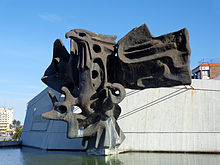| |
|---|---|
 A statue, representing a tribute from the Armenian Collective to the Uruguayan government, located in Montevideo. | |
| Total population | |
| 15,000[1] – 20,000[2] | |
| Regions with significant populations | |
| Montevideo | |
| Languages | |
| Uruguayan Spanish, Armenian | |
| Religion | |
| Armenian Apostolic, Armenian Catholic, Evangelical and Protestant | |
| Related ethnic groups | |
| Armenian, Armenian Argentines |
| Part of a series on |
| Armenians |
|---|
 |
| Armenian culture |
| By country or region |
Armenian diaspora |
| Subgroups |
| Religion |
| Languages and dialects |
|
Armenian: Eastern (Zok) • Western (Homshetsi) Sign languages: Armenian Sign • Caucasian Sign Persian: Armeno-Tat Cuman: Armeno-Kipchak Armenian–Lom: Lomavren |
| Persecution |
Armenian Uruguayans (Armenian: Հայերն Ուրուգվայում, romanized: Hayern Urugvayum; Spanish: Armenio-uruguayos) number around 15,000–20,000 of the population, making Uruguay to have one of the largest Armenian diaspora populations around the world.[2] The Armenian community in Uruguay is one of the oldest communities[clarification needed] in South America, with most of them residing in the capital Montevideo. The majority of Armenians in Uruguay are either third or fourth-generation descendants of the first wave of immigrants coming from the Ottoman Empire between the end of the 19th century and the Armenian genocide.
- ^ AGBU – AGBU XVIII World Games Takes Montevideo by Storm, 1,000 People Participate Archived December 5, 2010, at the Wayback Machine
- ^ a b ArmenianDiaspora website Archived May 11, 2013, at the Wayback Machine